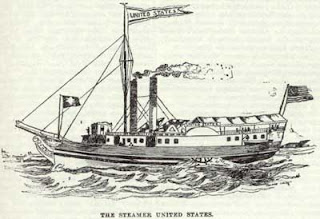Under Birge’s unsanctioned battle plan, unarmed men were to board the passenger steamer United States in Oswego on November 9 before it set out on its usual route to Ogdensburg. Other men would board the steamer at each town as it followed its schedule to Ogdensburg, the American town directly across the river from the attack target, Prescott, Upper Canada. With his orders given, General Birge departed for Ogdensburg ahead of the steamer to organize more men in that town.
Hunter Admiral Bill Johnston had purposely stayed out of Birge’s conspiracy but knew every detail of the plan. He too traveled to Ogdensburg in one of his boats ahead of the attack on Prescott. His odd reason, as he explained to friends and family, was: “That way I can stay out of the way of all parties.”
On November 10, two schooners, the Charlotte of Oswego and Charlotte of Toronto, departed from Oswego, New York. Carrying Hunter troops under the command of Colonel Nils von Schoultz, they headed towards the Thousand Islands. Their cargoes included six cannon ranging from a puny 3-pounder to a lethal 18-pounder. Their holds and decks were crammed with crates of modern rifles, including some of the recently-invented multiple-round rifles, plus ammunition, food, medical supplies, and other kit of war.
Aside. All historical accounts I have read that were written since the late 19th century, except one, say Bill Johnston captained one of the two schooners. That is fiction. None of the many eye-witness accounts place him on either schooner. This misfact probably began as anti-Johnston propaganda in Canada and was passed on by generations of historians as truth.
Spies Report Hunter Activity
British spies in upstate New York, some within the Hunter ranks, were sending regular reports back to military authorities in Canada. It was clear an invasion was underway but the exact landing point was still speculative.John Colborne, 50, commander-in-chief of British forces in the Canada, alerted all militia and regular army units to be on the ready. On November 10, Heley Chamberlain, a Hunter spying for the British, told Captain Williams Sandom about a Hunter force bound for Prescott. Sandom, 53, naval commander on Lake Ontario and a veteran of 60 naval engagements, ordered armed steamers to patrol the lake and St. Lawrence River.
Hunter Fighters Hijack Steamer
Delayed for two days by boiler repairs, the United States readied to depart the morning of Sunday, November 11. As the captain, James Van Cleve, 30, prepared to cast off, a long column of passengers in civilian clothes—-mostly young men with no baggage-—boarded the ship. Senior Hunter officers Martin Woodruff, Dorephus Abbey, and Daniel George milled among the new passengers. |
| The United States, a side-wheel steamship |
At midday, the United States stopped in Sackets Harbor. Waiting to board was Captain Daniel Heustis and a small band of men. A week earlier, Sackets Harbor teemed with 500 eager Hunter recruits, but their ardor for war cooled as they waited for repairs to the steamer. Most returned home.
In his memoirs, Heustis recalled his conversation at Sackets Harbor with Colonel Woodruff when they realized they had just 180 men and only five of the promised 500 Poles.
Heustis: “Our scheme will fail, I fear. We shall be defeated.”
Woodruff: “I can’t back out now and neither can you. I’d prefer to be shot. We must go and do our best.”
Heustis: “I will go. I would rather die than be branded a coward. Whatever might be the issue, we ought to meet it as men fighting in a good cause.”
The United States sailed up to Cape Vincent where a few more Hunters boarded. Further east, at Millens Bay, the two Hunter schooners lay at anchor. Daniel George, pretending to be a businessman, paid Captain Cleve $100 to tow the schooners. With a schooner lashed on each side, the United States continue downstream.
After a brief stop at Clayton, the true nature of the schooners became apparent. On the Charlotte of Toronto, von Schoultz emerged with a sword scabbard visible beneath his long cloak. Hundreds of other men flooded the decks on both schooners. They pried open the crates lashed to the decks and armed themselves with rifles. The Hunter army sailing to Prescott now numbered 400. Captain van Cleve was no longer in control of his ship.
Von Schoultz conferred with the other officers. General Birge had ordered the fleet to stop at Ogdensburg to pick up more recruits. Von Schoultz wanted to sail straight to Prescott, believing that men would desert at Ogdensburg. The other officers agreed and appointed von Schoultz their commander in chief.
Attack on Prescott Begins
That evening, as the United States approached Morristown, New York, von Schoultz ordered all Hunters to board the schooners. Half failed to follow his order. Von Schoultz left Colonel Abbey in charge of the deserters on the steamer, hoping he’d change their minds. With his diminished force, von Schoultz sailed into the dark night.At Morristown, Captain van Cleve told authorities about being hijacked by Hunters, and continued to Ogdensburg, reaching there about 3 a.m., November 12. Minutes earlier, the ship’s passengers heard a rapid series of musket shots coming from across the river at Prescott.

0 comments:
Post a Comment